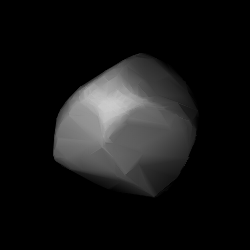Astronomy:400 Ducrosa
From HandWiki
Short description: Main-belt asteroid
 Modelled shape of Ducrosa from its lightcurve | |
| Discovery | |
|---|---|
| Discovered by | Auguste Charlois |
| Discovery date | 15 March 1895 |
| Designations | |
| (400) Ducrosa | |
| Named after | J. Ducros |
| 1895 BU | |
| Minor planet category | Main belt |
| Orbital characteristics[1] | |
| Epoch 31 July 2016 (JD 2457600.5) | |
| Uncertainty parameter 0 | |
| Observation arc | 121.08 yr (44225 d) |
| |{{{apsis}}}|helion}} | 3.49063 astronomical unit|AU (522.191 Gm) |
| |{{{apsis}}}|helion}} | 2.76117 AU (413.065 Gm) |
| 3.12590 AU (467.628 Gm) | |
| Eccentricity | 0.11668 |
| Orbital period | 5.53 yr (2018.6 d) |
| Average Orbital speed | 16.84 km/s |
| Mean anomaly | 294.184° |
| Mean motion | 0° 10m 42.013s / day |
| Inclination | 10.5354° |
| Longitude of ascending node | 327.145° |
| 238.468° | |
| Earth MOID | 1.7762 AU (265.72 Gm) |
| Jupiter MOID | 1.59886 AU (239.186 Gm) |
| TJupiter | 3.178 |
| Physical characteristics | |
| Dimensions | 33.66±1.6 km |
| Rotation period | 6.87 h (0.286 d)[1] 6.87 ± 0.01 hours[2] |
| Geometric albedo | 0.1423±0.014 |
| Absolute magnitude (H) | 10.5 |
Ducrosa (minor planet designation: 400 Ducrosa) is a typical Main belt asteroid. It was discovered by Auguste Charlois on 15 March 1895 in Nice.
Photometric measurements of the asteroid made in 2005 at the Palmer Divide Observatory showed a light curve with a period of 6.87 ± 0.01 hours and a brightness variation of 0.62 ± 0.02 in magnitude.[2]
It is named for J. Ducros, a mechanic at the Nice Observatory.[3]
References
- ↑ 1.0 1.1 "400 Ducrosa (1895 BU)". JPL Small-Body Database. NASA/Jet Propulsion Laboratory. https://ssd.jpl.nasa.gov/sbdb.cgi?sstr=400;cad=1.
- ↑ 2.0 2.1 Warner, Brian D. (2005), "Asteroid lightcurve analysis at the Palmer Divide Observatory - winter 2004-2005", The Minor Planet Bulletin 32 (3): pp. 54–58, Bibcode: 2005MPBu...32...54W.
- ↑ Schmadel, L. D. (2013:73). Dictionary of Minor Planet Names. Germany: Springer Berlin Heidelberg.
External links
- Lightcurve plot of 400 Ducrosa, Palmer Divide Observatory, B. D. Warner (2005)
- Asteroid Lightcurve Database (LCDB), query form (info )
- Dictionary of Minor Planet Names, Google books
- Asteroids and comets rotation curves, CdR – Observatoire de Genève, Raoul Behrend
- Discovery Circumstances: Numbered Minor Planets (1)-(5000) – Minor Planet Center
- 400 Ducrosa at AstDyS-2, Asteroids—Dynamic Site
- 400 Ducrosa at the JPL Small-Body Database
 |


